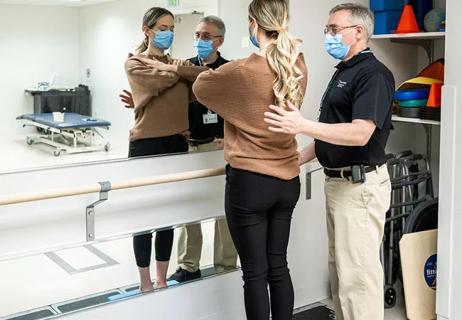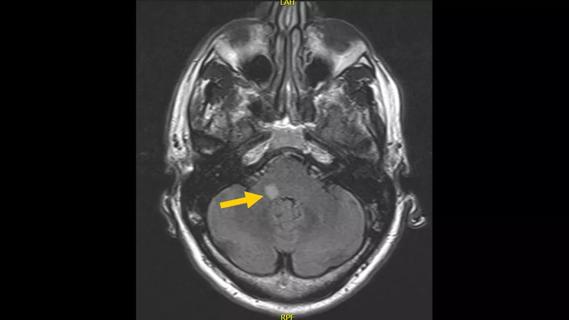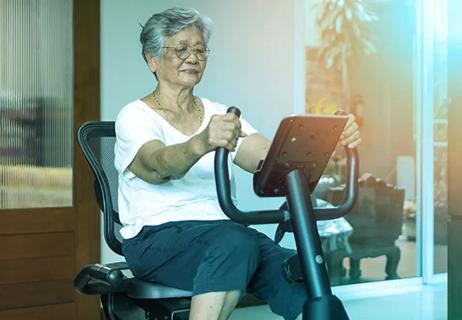How a new clinic is helping to streamline evaluations for patients
When it comes to vestibular disorders, there is usually a great deal to consider when determining the root cause of the patient's symptoms.
Advertisement
Cleveland Clinic is a non-profit academic medical center. Advertising on our site helps support our mission. We do not endorse non-Cleveland Clinic products or services. Policy
“What we always tell patients is that we act as investigators for the referring provider or the medical doctor,” says Evalena Behr, AuD, an audiologist in Cleveland Clinic’s Vestibular and Balanced Disorders Program. “We really measure the function of the vestibular system, not necessarily the structure. We're looking at whether the ears or the vestibular system are sending equal and symmetrical information to the brain about really where the head and body are in space. One thing that we're looking at with that is how we can help localize – if the vertigo is coming from the right ear versus the left - and sometimes it's important for our referring providers to correlate that with hearing to help discern the diagnosis.”
In a recent episode of Cleveland Clinic’s Head and Neck Innovations podcast, Dr. Behr and Julie Honaker, PhD, AuD, Section Head of Audiology at Cleveland Clinic share new research and innovations and what’s happening in Cleveland Clinic’s new Dizzy Clinic. They discuss:
Click the podcast player above to listen to the episode now, or read on for a short edited excerpt. Check out more Head and Neck Innovations episodes at clevelandclinic.org/podcasts/head-and-neck-innovations or wherever you get your podcasts.
Advertisement
Podcast host Paul Bryson, MD, MBA: What are some of the care paths that can be used to treat vestibular disorders, and which treatment options do you see most commonly as a starting point?
Julie Honaker, PhD, AuD: I think one thing just kind of shed some light on vestibular disorders — it really comes down to our role kind of as those investigators and getting to the root cause of the patient's symptoms.
So, dizziness, balance and vertigo. Those are debilitating symptoms that one may experience, but they're internal symptoms, and it's often very difficult for patients to describe truly what they're experiencing. [It’s difficult] for providers to identify the culprit because there are so many different systems, whether it's peripheral, neurologic, cardiovascular, blood pressure related, even medication-related causes and natural aging effects, that could be a source for why somebody would be experiencing those symptoms.
Oftentimes we say the best care path is for patients to first have a conversation with their primary care or their family practice provider regarding their symptoms. From there, depending on the symptoms, if there’s something that sounds like it's more triggered, there is an ear-related co-occurrence where they're having perhaps hearing-related problems, ringing in the ears, pain in their ears or discharge that might send them more our path within the realm of ENT-audiology and where our testing may come into play to help determine what could be the cause.
Sometimes if it's just something that's more position trigger changes for their symptoms, their symptoms are very brief, and they're truly something that's isolated where the patient can really tell you what's bringing it on or it's only lasting for a few seconds. Sometimes they can still see us as a first care path or sometimes they can even be seen by physical therapy as a route to rule out the most common cause for vertigo and dizziness. This is a problem referred to as benign paroxysmal positional vertigo or where somebody has tiny little dense gravitational crystals within their ear structures can become dislodged. When this happens, it can bring on transient symptoms of vertigo. Sometimes if they have neurologic causes, it's a path to get them to neurology first.
Advertisement
So it's oftentimes having patients just open up with their family practice to determine what the symptoms are, what are associated symptoms and triggers, and that can help allude to what path might be the best route for management first.
Advertisement
Advertisement

A comprehensive evaluation and multidisciplinary care are key to caring for patients with vestibular disorders

When a patient failed to improve, the value of a comprehensive vestibular test was apparent

Subtle information gleaned from clinical examinations prompted concern

Gait becomes more normalized along with gains in speed

Case study illustrates the potential of a dual-subspecialist approach

Evidence-based recommendations for balancing cancer control with quality of life

Study shows no negative impact for individuals with better contralateral ear performance

HNS device offers new solution for those struggling with CPAP